|
| You Can Do IT |
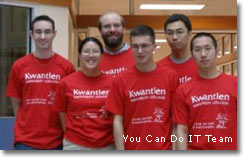
Normally, I have a lot of fun coming up with splashy titles for my Jade Project Articles. But this time, nothing I could come up with was cleverer than the actual name of Dr. Andy Law’s programme: “U Can Do IT”.
Andy, who is the chair of the Computing and IT Department at Kwantlen University, didn’t just mix up his capital and lowercase letters when he came up with the title, either. “U” stands for “youth” and “IT” stands for “information technology”.
Andy is concerned that there is a declining interest in computer science among young people, perhaps because high school students are not “receiving the correct message about the future of IT”. Didn’t the IT bubble burst back in the 90’s? Not at all, I learned. In fact, employers, he says, are having trouble filling positions in the infotech field.
As someone who relishes finding creative solutions to problems, Andy saw a golden opportunity to both excite youth about infotech and give the students in his Software Engineering Implementation class a unique learning experience. He designed a competition for high school students. His class of Bachelors of Technology students would run the competition and manage the teams. Through this, they would learn a lot about teamwork, project management and real world problem solving. At the same time, the younger students learn a lot from their visiting students. From these enthusiastic role models, the high school kids can see first hand that there is a bright and interesting future in IT.
So what does this competition look like? There are two rounds. In the first round, students have class time to complete a written test based on an eBook of facts about the IT industry. The book is compiled by IT students and professionals. The BTech students mark the papers onsite, and a male and female winner from each school is chosen to compete in the final round.
The final round is a “virtual” test in which the winners compete online! One overall female winner and one male winner are chosen and each wins a $100 gift certificate from Chapters.
Andy also would like to see more females excited about studying computer science. Another goal of his U Can Do IT competition is to let everyone know that females can do just as well as males in the field. When his university students visit high schools, he makes sure that there is a mix of guys and girls to show that women can be just as successful. This is also reflected in the prize distributions – they select one male and one female winner to promote female participation in the competition.
Where does U Can Do IT go from here? Last year, over 500 students from 22 schools were visited and invited to participate in the competition. (Which shows Andy’s dedication, since he accompanies each visit to make sure things run “smoothly”!). The competition has been “well received” by all the schools. Ambitious Andy hopes to expand the competition to even more students in the future. After all, “the number [500] is still small compared to the actual size of high school students in the world”.
To conclude our interview, I asked him my favourite question. What is his advice to high school students who might want to get involved in the IT field? He suggests doing research into the fields that interest you, in order to avoid misconceptions.
“Today’s IT professionals are no longer working long hours in front of a computer screen.” IT requires “innovative minds” to solve real-world problems.
So read up and let your creativity flourish!.
|
|
|
| Heart-Lung Machines and Airplanes |

Just because something is cute doesn’t mean it’s not effective. Ora Steyn’s Cuter Computer Challenge (CCC) may include a prize for the best-dressed team, but it also offers high school girls from 13-17 the chance to learn the “skill set needed to succeed in the IT industry”.
Like Andy Law, UCFV professor Ora Steyn believes that creativity and fun is not at odds with a career in information technology. She encourages young women not to stifle their imagination, but to incorporate it into approaches to solving computer science problems. “I love programming”, says Ora, “and would like to be able to share my enjoyment with other females out there”.
During her six years teaching in the Computer Information Systems Department at UCFV, she was also concerned about the low number of women enrolling in the program. She makes the very good point that the
"IT industry needs the skill set females have - after all half of computer users are female. ”
She tried different ways of reaching out to girls and getting them excited about a career in computer science, and discovered that the CCC was one of the most effective ways. Cuter Computer delivers a mix of interesting content and pizzazz. Students work in pairs and complete four computer challenges designed by IT industry professionals and student volunteers. The grand prize is a Nintendo DS! (But alas, unfortunately I am too old to enter the challenge).
That’s not all CCC has to offer. For example, one of the coolest features of the CCC is a panel of females from the UCFV computer information systems department and from the IT industry. This gives the young women a chance to meet role models and have their questions answered. There are also quirky challenges too, such as a prize for the most creative title. Last year’s winner, Ora tells me, was “Team LOL”.
This year’s competition happened on October 20, 2007. To find out more, visit the Cuter Computer website: http://www.ucfv.ca/cis/Prospective/CCCTobebrief.htm. If you live in the Abbotsford area and are interested in participating in next year’s Cuter Computer Challenge, you can register online.
Finally, Ora has two pointers for young women who might be interested in getting into a career in IT. First of all, make sure you take the correct high school courses to get into the program of choice. Second, “do not be intimidated by the boys!” IT professionals write the code that controls the “heart-lung machines, the ventilators and airplanes” – not just games :) |
|
|
| Due North |
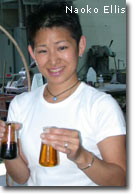 What fuels Dr. Naoko Ellis? Apparently, French fry oil and the development of more sustainable and environmentally responsible energy sources! In waste cooking oil, Naoko sees the source of a cleaner fuel for the future. What fuels Dr. Naoko Ellis? Apparently, French fry oil and the development of more sustainable and environmentally responsible energy sources! In waste cooking oil, Naoko sees the source of a cleaner fuel for the future.
Ever since she was a kid, Naoko has been concerned about issues of waste. Her mother, a professor of chemistry, inspired her to learn about waste management techniques in chemistry, chemical engineering and environmental engineering. Now, as a faculty at UBC, Naoko conducts research into alternative energies. One of the unique projects she is involved in is the production of a natural fuel called biodiesel from none other than used cooking oil. The project started when two of her students brought forth a brilliant idea for converting used French fry grease from campus food outlets into a useful energy source.
She is on the leading edge of research that could help address the number one concern of Canadians today: climate change. Biodiesel produces less carbon dioxide than gasoline based on the life cycle analysis. But it also has lots of other benefits, both environmental (such as the fact it is non-toxic and biodegradable, so spills would not be harmful to wildlife) and political (such as the fact that it can be produced locally). It also eliminates waste – what could be better!
Now, the team has developed a way to convert the waste oil from UBC Food Services (which serves food to thousands of students each day) into biodiesel. The UBC Plant Operations team has already started to use this biodiesel in their lawncare equipment, etc. To read more about this initiative and about how “French Fries Fuel the Future”, you can go to the following link: www.eya.ca/files/attachments/10_French_Fries_Future.pdf
In her free time, Naoko was key in instituting a creative program called North of 60°. Through North of 60°, she hopes to bring the principles of sustainability to high school students in northern British Columbia and the Yukon. “We wanted to reach students who have less exposure and accessibility to things that were perhaps more available in the lower mainland,” says Naoko. She and her teams of volunteers visit areas in northern Canada. Here, they conduct multifaceted workshops with students in grades 8 through 12.
Students learn “How can science and engineering make a difference” through the example of Naoko’s biodiesel initiative. As a case study of how scientific innovations can make a difference, students learn and discuss how the biodiesel initiative was started and how it can be implemented in other communities.
Then the volunteers present a unit on water quality in developing nations. This is accompanied by a hands-on project on water filtration techniques. Students also participate in a brainstorming session about how science and engineering can relate to their lives. The volunteers also have a chance to tell students about their own personal interest in sustainability, science and engineering and how the students can go on to pursue their own interests.
Naoko hopes to help girls in the region build confidence in their engineering and science skills, and support them in their aspirations to go on in those fields. Females tend to be particularly interested in environmental and international development issues, and Naoko feels she can empower young women in the north to tackle these issues.
What’s next for the North of 60° program? Naoko hopes that next year they will be able to visit the Northwest Territories.
Her advice for someone who is interested in getting involved in a career like hers is, to “be curious!” “Explore your interest and possibilities. Reach out, approach and ask questions to role models that you may come across. Engage yourself in many different things and situations and find out what excites you.” Excitement seems like the natural fuel that drives Naoko to improve the world.
|
|
| Building Communities Connects Women in Engineering in British Columbia |
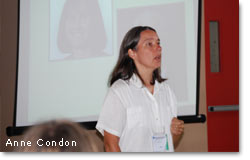 On September 15 and 16, 2007 approximately 120 women engineers, engineering students and faculty gathered at the Loon Lake in Maple Ridge to participate in the Building Communities Symposium (BCS). The vision for this event was the development of a network of women in engineering in BC, where students, new immigrant engineers, women returning to work and established industry professionals alike have the opportunity to build a supportive and inclusive community for each other. On September 15 and 16, 2007 approximately 120 women engineers, engineering students and faculty gathered at the Loon Lake in Maple Ridge to participate in the Building Communities Symposium (BCS). The vision for this event was the development of a network of women in engineering in BC, where students, new immigrant engineers, women returning to work and established industry professionals alike have the opportunity to build a supportive and inclusive community for each other.
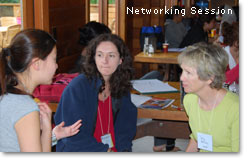 This event was designed to provide the catalyst for building networks of women across engineering workplaces, industries, and university faculties. The programming focused on developing leadership skills, facilitating outreach and advocacy, creating mentoring relationships, and developing support networks that to allow more women to reach senior positions in their industries. This event was designed to provide the catalyst for building networks of women across engineering workplaces, industries, and university faculties. The programming focused on developing leadership skills, facilitating outreach and advocacy, creating mentoring relationships, and developing support networks that to allow more women to reach senior positions in their industries.
Creating an atmosphere that makes women feel more included is crucial to maximizing their productivity, success and happiness.
The event featured a number of keynotes speakers. On the first day, Anne Condon, NSERC/GM Chair for Women in Science and Engineering opened the event with a magical discussion on the Art of Networking and Ms. Janet Benjamin, recently elected president of the Association of Professional Engineers and Geoscientists of BC, closed the day with a directed and empowering talk on marketing and engineering.
On day two, Ann English, Director of the 2010 Olympic Initiative at BC Hydro, gave a very compelling personal account of her career path and management experience within several engineering companies and Elizabeth Croft, Associate professor of Mechanical Engineering, UBC challenged the attendees to Believe, Calculate and Succeed.
Participants also took part in a wide variety of breakout workshops and panel discussion designed to meet the needs of women engineering professionals at all stages of the career. The closing session of the symposium provided a directed opportunity for further networking. New and established groups were formed and expanded around various communities including DAWEG, Women in Engineering UBC, Women in Academe, Internationally Trained Engineers, GEERing Up, etc. This activity provided a venue for these to vision and plan a community activity, with access to supporting funding from BCS.
Building Communities was a resounding success, due to the hard work of the organizing committee, as well as large number of volunteers. In our post event survey, 98% of respondents felt that the event should be repeated, over 90% of respondents agreed that they had strengthened their engineering network, and almost 80 % were more confident in their ability to succeed. A follow-up event is scheduled for January 2008 and the planning for the next BCS is ongoing. The support of our sponsors, partially listed below, is gratefully acknowledged for helping to make this event a reality for women in engineering in British Columbia. A complete list of sponsors can be found at www.mech.ubc.ca/~wesymposium/Sponsors.htm.
Diamond
NSERC/CRSNG Pacific
Platinum
The Jade Project
Gold
Teleflex Canada
Toyota CAPTIN
UBC Department of Mechanical Engineering |
BC Hydro
JV Driver |
Building Community Symposium Organizing Committee
Chair – Anja Lanz
Faculty Advisor – Elizabeth Croft
Program Planning Coordinator – Bernadette Currie
Communications Director – Jennifer Pelletier
Venue Committee – Nicole Bennett and Veronica Lau
Marketing and Promotions Committee – Jennifer Pelletier, Michelle La Haye, Setareh Aslani, Hengameh Hoseini, and Jasna Jankovic
Registration Committee – Nicole Bennett, Sandra Zheng, Caryn Liberman, Erin Brophy, Mojgan Kavoosi, and Neda Abdollahzadeh
Volunteer Coordination Committee – Resha Hamze, Erin Biddlecombe, and Susana Zoghbi
Finance and Sponsorship Committee – Jennifer Pelletier, Susana Zoghbi, Irene Chien, Bing Dai, Katie Bruce, and Sherry Ding
Webmasters – Irene Chien and Olha Lui
Staff Advisor – Erin Biddlecombe
|
|
|


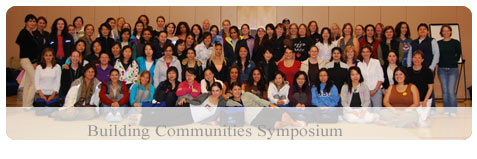


 What fuels Dr. Naoko Ellis? Apparently, French fry oil and the development of more sustainable and environmentally responsible energy sources! In waste cooking oil, Naoko sees the source of a cleaner fuel for the future.
What fuels Dr. Naoko Ellis? Apparently, French fry oil and the development of more sustainable and environmentally responsible energy sources! In waste cooking oil, Naoko sees the source of a cleaner fuel for the future.  On September 15 and 16, 2007 approximately 120 women engineers, engineering students and faculty gathered at the Loon Lake in Maple Ridge to participate in the Building Communities Symposium (BCS). The vision for this event was the development of a network of women in engineering in BC, where students, new immigrant engineers, women returning to work and established industry professionals alike have the opportunity to build a supportive and inclusive community for each other.
On September 15 and 16, 2007 approximately 120 women engineers, engineering students and faculty gathered at the Loon Lake in Maple Ridge to participate in the Building Communities Symposium (BCS). The vision for this event was the development of a network of women in engineering in BC, where students, new immigrant engineers, women returning to work and established industry professionals alike have the opportunity to build a supportive and inclusive community for each other.  This event was designed to provide the catalyst for building networks of women across engineering workplaces, industries, and university faculties. The programming focused on developing leadership skills, facilitating outreach and advocacy, creating mentoring relationships, and developing support networks that to allow more women to reach senior positions in their industries.
This event was designed to provide the catalyst for building networks of women across engineering workplaces, industries, and university faculties. The programming focused on developing leadership skills, facilitating outreach and advocacy, creating mentoring relationships, and developing support networks that to allow more women to reach senior positions in their industries.